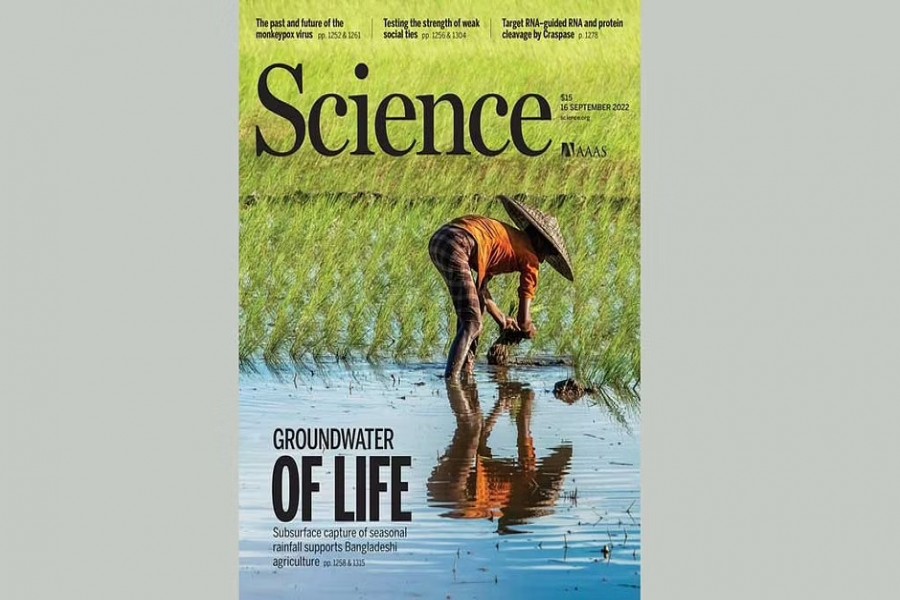A group of researchers have empirically identified a nature-based solution, described as the Bengal Water Machine, to seasonal freshwater storage capture that rivals the world's largest dams, bdnews24.com reports.
The study showed that the collective operation of around 16 million smallholder farmers in the Bengal Basin of Bangladesh from 1988 to 2018 has induced cumulative freshwater capture which is 75 to 90 cubic kilometres in volume, or equivalent to twice the reservoir capacity of the Three Gorges Dam in China.
In 1975, researchers R Revelle and V Lakshminarayana proposed an alternative solution to freshwater storage in the River Ganges Basin in which incremental increases in dry-season groundwater pumpage for irrigation near river channels lower groundwater levels and enhance leakage under gravity of river flow during the subsequent monsoon.
Dubbed the Ganges Water Machine, this intervention seeks to increase the capture and storage of seasonal freshwater surpluses while mitigating the monsoonal flood risk.
The latest study, published in Science magazine on Sept 16, extended the concept of freshwater capture of monsoonal flows beyond perennial rivers to include a range of surface waters, such as ponds, canals, and seasonal rivers, diffuse recharge through enhanced local drainage, and irrigation return flows in the Bengal Basin.
The researchers described this broader set of recharge pathways induced by dry-season groundwater pumping as the Bengal Water Machine, or BWM.
Evidence of its operation in the Bengal Basin of Bangladesh has been noted previously where amplification of seasonal groundwater recharge occurs as a consequence of dry-season groundwater-fed irrigation for rice cultivation.
The new analysis shows how the collective action of millions of smallholder farmers abstracting shallow groundwater to irrigate a dry-season rice crop in a tropical alluvial plain has achieved freshwater capture that rivals the world's largest dams.
In doing so, the study confirmed the vision of this nature-based solution to seasonal freshwater capture, following a broader set of pathways than first proposed in Science in 1975 by Revelle and Lakshminarayana.
"Because alluvial plains in the seasonally humid tropics cover an area of nearly 4 million square kilometre, there is scope to scale up operation of the BWM to improve the sustainability of irrigated food production globally," the study said.
"Evidence from the Bengal Basin, the most intensely monitored alluvial plain in the world, highlights the pivotal role played by surface geology in enabling the transmission of induced recharge.
"Improved planning of irrigated agriculture that explicitly recognizes operation of the BWM in seasonally inundated alluvial plains can optimise freshwater capture and minimise groundwater depletion where this capture is insufficient to sustain groundwater-fed irrigation. Of strategic importance is the demonstrated resilience of this conjunctive use of groundwater and surface water to hydrological extremes that are amplified by climate change."
The researchers who authored the study are Mohammad Shamsudduha, Richard G Taylor and Md Izazul Haq of University College London, Sara Nowreen of Bangladesh University of Engineering and Technology, Anwar Zahid of Bangladesh Water Development Board and Kazi Matin Uddin Ahmed of Dhaka University.
LIMITATIONS
Important limitations to the operation of the BWM are evident from compiled hydrographs, which reveal locations where induced monsoonal recharge is insufficient to fully replenish groundwater abstracted during the dry season.
For example, areas with a surface geology of low permeability restrict the BWM and coincide with dry-season groundwater levels less than 8 metre below ground that render groundwater inaccessible to households reliant on shallow wells.
Furthermore, the Barind region and Ganges floodplain in western Bangladesh, where observed groundwater recharge approaches or exceeds potential recharge – the latter governed by rainfall, surface geology, and flood extent – are most at risk of realising the limits of increased freshwater capture through the BWM.
Consequently, opportunities to expand operation of the BWM in Bangladesh are now largely restricted to the River Brahmaputra floodplains.
Anwar, a groundwater specialist of BWDB and co-author of the study, said in some areas, such as Nilphamari and Tangail, groundwater level drops below three to 10 metres during the dry season and recovers the level after monsoon.
"But in Dhaka, it has dropped below 82 metres. It doesn’t recharge, but drops further every year."
"These vulnerable areas will need to be brought under management."
He also said the government was thinking about artificial storage of rainwater to recharge the areas where groundwater levels are dropping.
Co-authors Sara Nowreen of BUET’s Institute of Water and Flood Management Kazi Matin of Dhaka University’s geology department said more study is needed to capture monsoon water for future use.
Professor Tarekul Islam of BUET’s Institute of Water and Flood Management said the findings of the study showed BWM’s effects in flood moderation.
"The researchers showed that the water would have flown to the Bay of Bengal had we not used it for irrigation. Now the groundwater is used for farming and floodwater is channelled to the ground. It moderates the floods a bit."


